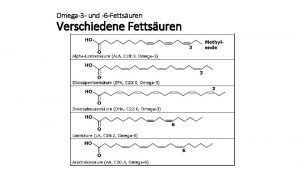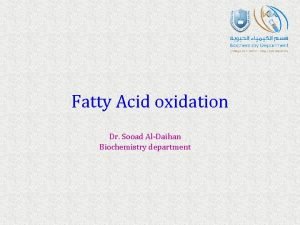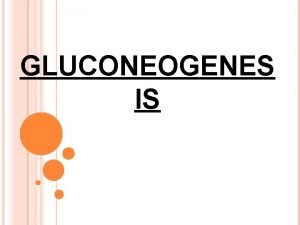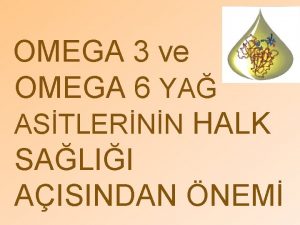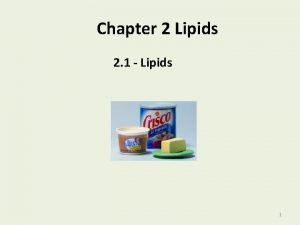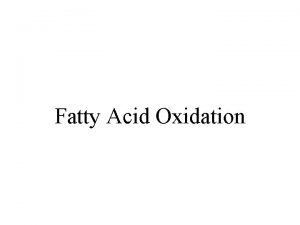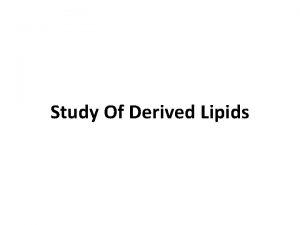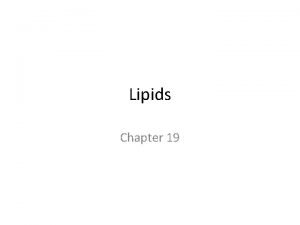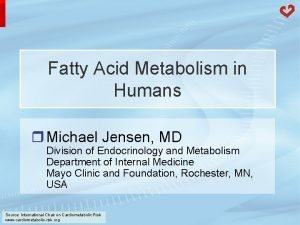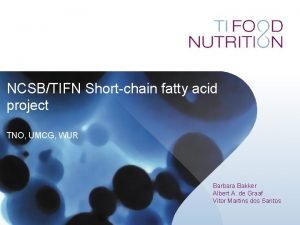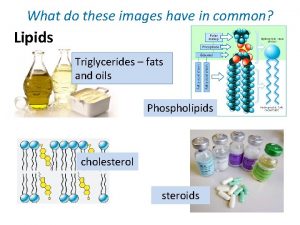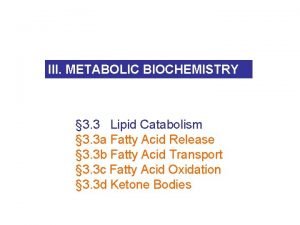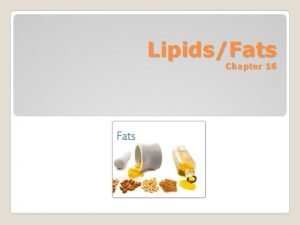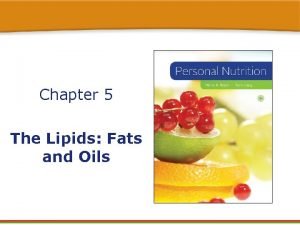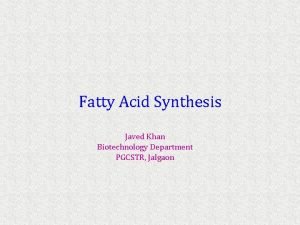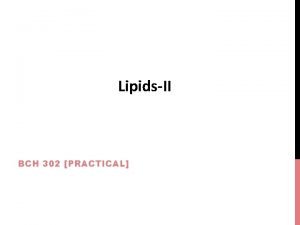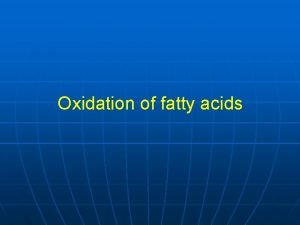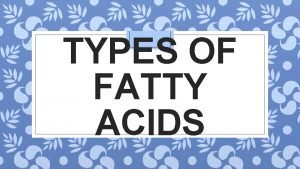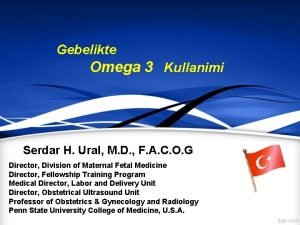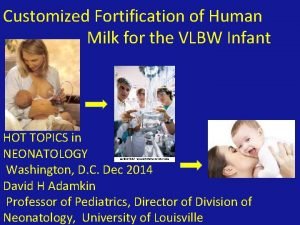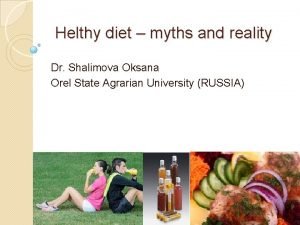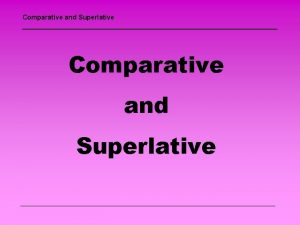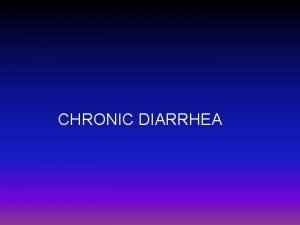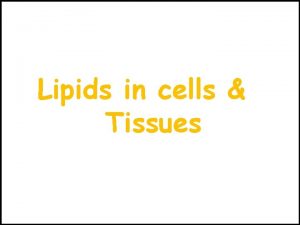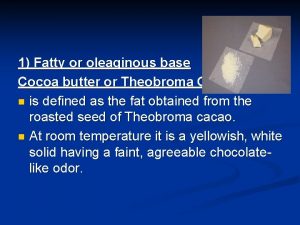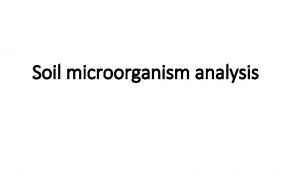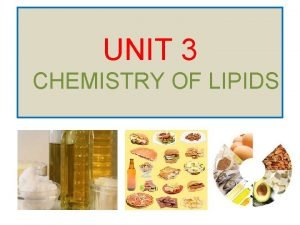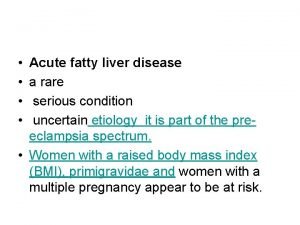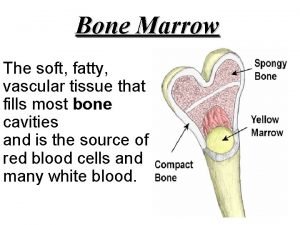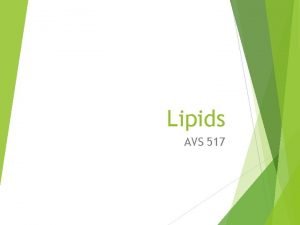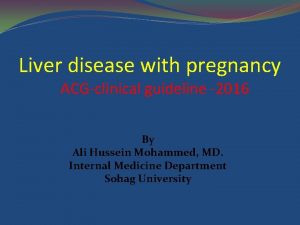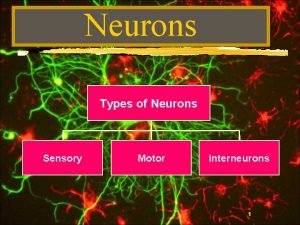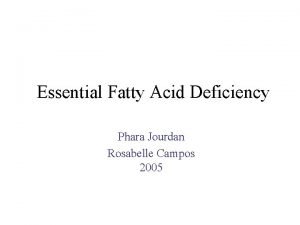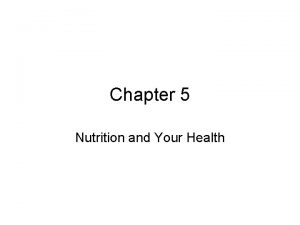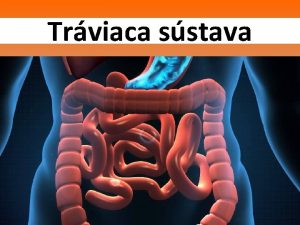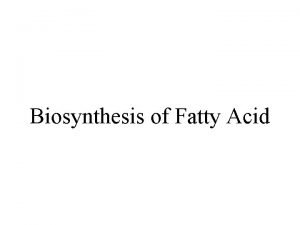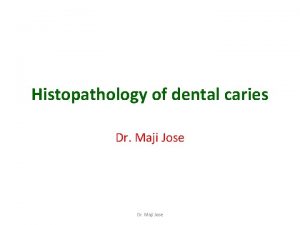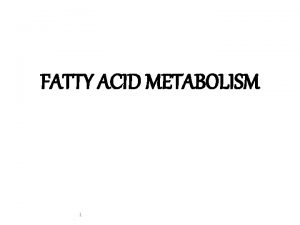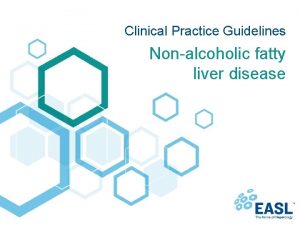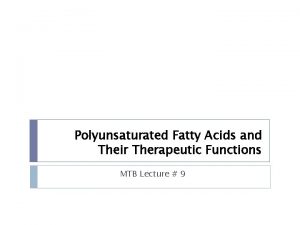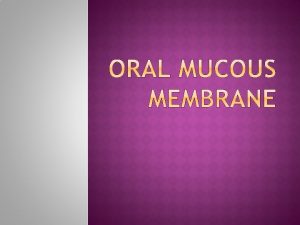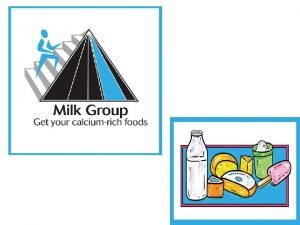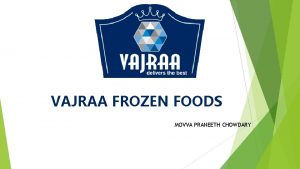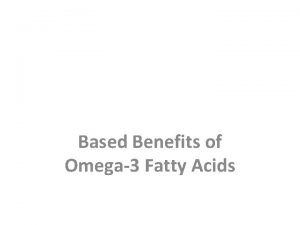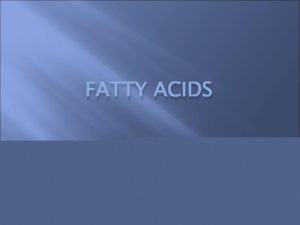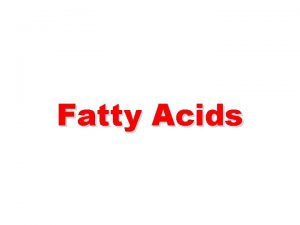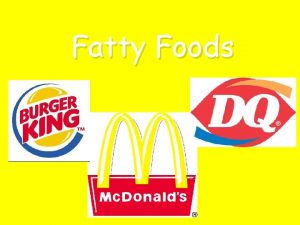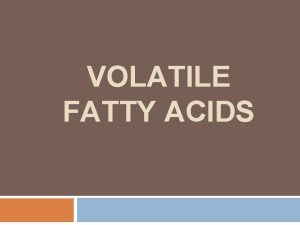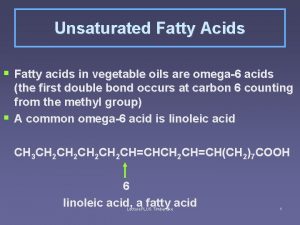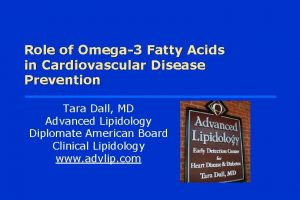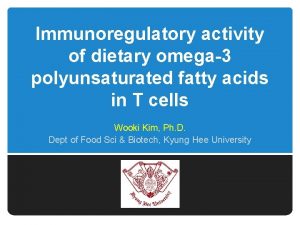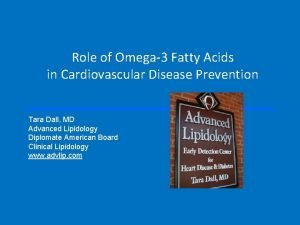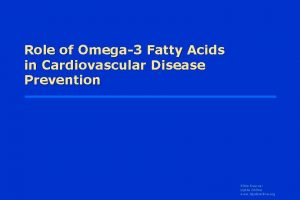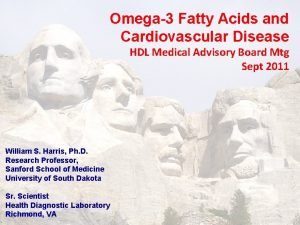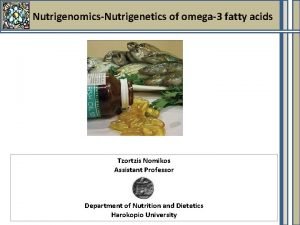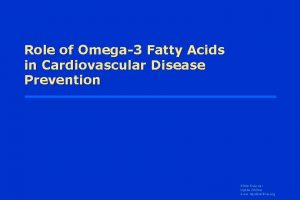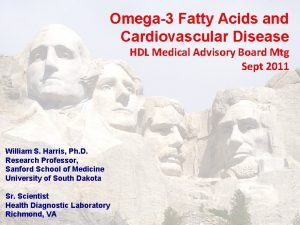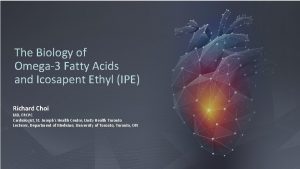Fortification of Foods With Marine Omega3 Fatty Acids





























































- Slides: 61

Fortification of Foods With Marine Omega-3 Fatty Acids: Food Technology Issues Mukund V. Karwe, Ph. D. Department of Food Science and Center for Advance Food Technology Rutgers University “Seafoods: Assessing the benefits and risks”, June 8, 2004, Cook College 1

Contributors/Collaborators Dr. Chi-Tang Ho (flavor and natural products chemistry) Dr. Geetha Ghai (biochemistry and nutraceuticals) Dr. Bob Rosen (analytical chemistry) Dr. Beverly Tepper (sensory evaluation) Dr. Rafael Borneo (post-doc) Ms. Ramapadmini Gadiraju (grad student) Ms. Sughra Naqvi (technician) 2

What are Marine Omega-3 Fatty Acids? • Long chain polyunsaturated fatty acids(LCPUFA): “good fat” • Derived from a-linolenic acid (ALA or 18: 3 Omega-3), an essential fatty acid • Important for brain development, nerve development, alleviating CVD, autoimmune disorder, atherosclerosis : healthy living 3

EPA and DHA Major examples of long chain Omega-3 fatty acids EPA (20: 5) DHA (22: 6) (Eicosapentaenoic Acid) Lowers the level of cholesterol, cleans blood vessels, prevents stroke and irregularity of the heart (Docosahexaenoic Acid) Maintains and improves human memory and learning behavior 4

Greenland Eskimo Study • “Eskimo paradox” – traditional diet - high in fat and protein, low in fruit, fiber and leafy green vegetables – little evidence of heart disease and low blood cholesterol levels. • Greater intake of seal, whale and fish (all contain high levels of DHA and EPA) • Lower intake of omega-6 fatty acids • Lead to interest in omega-3 fatty acids in fish oil for prevention of CVD Ref. : Rosenberg. Fish-food to claim the Heart-Perspective- N. Engl. J. Med. , 2002: Vol 346: No. 15: 1102 -03 5

Fish is Brain Food • Fish are high in DHA; brain has high DHA levels • Studies of patients suffering from schizophrenia and ADHD show that increasing levels of DHA has beneficial impact on brain function • Prior study with Eskimos showed benefits to the heart • Have blood thinning effect similar to aspirin • Possible protective roles in arthritis, hypertension, cancer and heart disease 6

Omega-3 and Omega-6 fatty acids § Omega-6 are fatty acids derived from linoleic acid (LA, 18: 2), also an essential fatty acid. They work with Omega-3 to promote health § Omega-3 and Omega-6 are precursors for the synthesis of eicosanoids – hormonelike compounds, regulators of immune and inflammatory responses 7

Both compete for the same enzymes LA ALA Omega-6: Omega-3 ratio is important! 8

Creating a Balance 4 10 Promote inflammation Vegetable fats Omega-6 Imbalance in “western” diet 1 Reduce inflammation Marine animals Omega-3 rising rate of inflammatory disease 9

Omega-3 and Omega-6 fatty acids in plant/seed oils Linoleic Acid (Omega-6) Linolenic Acid (Omega-3) Soybean (50 -57%) Flaxseed (35 -56%) Safflower (67 -83%) Soybean (5 -10%) Sunflower (48 -74%) Canola (6 -14%) Corn (34 -62%) Safflower Oil (0. 1%) Canola (16 -25%) Walnut (13%) Sesame (35 -50%) Olive oil (0. 2 -1. 5%) (Values in % of total fatty acids) 10

Fatty Acid Composition of Vegetables and Fruits ALA Vegetables/Fruits LA 18: 2 6 Ratio ( -6: -3) Avocado 1. 9 18: 3 3 0. 1 Bean, lima 0. 5 0. 2 2. 5 Bean, pinto 0. 2 0. 3 0. 66 Broccoli 0. 03 0. 1 0. 3 0 0. 01 - 0. 1 0. 2 0. 5 Lettuce 0 0. 1 - Mustard 0 0. 04 - Peas 0. 2 1 Raspberries 0. 2 0. 1 2 Soybean 0. 4 2. 1 0. 19 Spinach 0. 1 0. 9 0. 11 Strawberries 0. 1 1 Cauliflower Kale 19 11

Fatty Acid Composition of Nuts Linoleic Acid 18: 2 6 Alpha. Linolenic Acid 18: 3 3 Ratio ( 6: 3) Beechnuts 18. 4 1. 7 10. 8 Butternut 34. 0 8. 7 3. 9 Chia seeds 3. 4 3. 9 0. 87 Hickory 20. 9 1. 0 20. 9 Walnut, black 34. 2 3. 3 10. 4 Walnut, English 32. 3 6. 8 4. 8 Nuts and Seeds Simopoulos A. P, and Robinson J. 1999 b. The Omega Diet: The Lifesaving Nutritional Program 12 Based on the Diet of the Island of Crete. Harper Collins. New York.

Fatty Acid Composition of Fats and Oils NAME OF FAT/OIL Sat’d % Linoleic Acid % (18: 2 6) a-LA % (18: 3 3) Mono-un Sat’d % Ratio ( 6: 3) Canola/Rapeseed oil 7 22 10 61 2. 2 Flaxseed/linseed oil 10 17 55 18 0. 31 Safflower Oil 10 76 Trace 14 - Sunflower oil 12 71 1 16 71 Corn Oil 13 57 1 29 57 Olive Oil 15 9 1 75 9 Soybean Oil 15 54 8 23 6. 75 Lard 43 9 1 47 9 Beef Tallow 48 2 1 49 13 2

Intake Recommendations • FDA – Do not exceed 2 g/p/d from conventional food and dietary supplement sources • Simopolous et al. (2000): Omega-6: LA 4. 44, Omega-3: ALA 2. 22, EPA + DHA 0. 66 (g/p/d) Ref. : A. P. Simopolous. , A. Leaf, N. Salem Jr. , Workshop statement on the essentiality of recommended dietary intakes for omega-6 and omega-3 fatty acids. , Prostaglandins, Leukotrienes and Essential Fatty acids. 2000; 63(3), 119 -121. 14

Omega-3 Fatty Acids in Fish Souci S. W, Fachman W, and Kraut H. 1994. Food composition and nutrition tables. Ed. 5. CRC Press. Stuttgart (Germany), Medpharm/Boca Ratton, Ann Arbor, London, Tokyo. p. 1091. 15

How to increase Omega-3 intake • Eat more fatty fish • Take a supplement • Eat fortified foods 16

• Taking Omega-3 fatty acid capsules is like taking medicine pills • Increasing fish consumption is challenging and may not be possible. – Difficult to eat amount of fish needed – Vegetarians – People with fish allergies – Those who don’t like fish 17

Food Fortification • Food fortification is convenient and efficient – Allows one to eat assortment of foods fortified with Omega-3 fatty acids 18

Food fortification with Omega-3 Supplying Omega-3 fatty acids in the diet through fortified foods will meet the body’s metabolic needs better than a dietary supplement or pills. (Maki et al. , 2003) Maki et al. (2003) J. Food Sci: 68(3): 761 -764 19

However, Omega-3 fatty acids are • Prone to auto-oxidation – unstable with very short shelf life • Sensitive to air, heat, light and humidity • Generation of off-odors Solutions to minimize or eliminate these problems lie in Food Technology 20

Food Fortification Products Quality/ Company Omega Protein Houston Product Omega Pure Source Ingredients Delivery Menhaden oil 12 -18% EPA+712%DHA + vit E + TBHQ Add oil to food (Only GRAS fish oil in the US) Life Plus Co EPA PLUS Fish DHA+ EPA Dietary supplement capsules Hypermat Omega bar Flaxseed 11 g -3/bar Snack bar Roche Vitamins, NJ ROPUFA 30 (30% EPA+ DHA) Fish oil 25%EPA, 12. 5% DHA, C &E, rosemary extract Bulk, liquid Wacker Biochem, MI OMEGA DRY-1150 -3 w/i gcyclodextrin complex 6% omega-3, Stable at 100 °C for 30 min Powder Nutrinova, Germany DHActive. TM Micro Algae 43 % DHA 21 oil Conc.

We have used 1. ROPUFA ’ 10’ Omega-3 Food Powder (DSM) 2. ROPUFA ’ 75’ n-3 EE (DSM) 3. Omega. Dry Powder (Wacker) 22

ROPUFA ’ 10’ Omega-3 Food Powder • Spray Dry Product (5% moisture) • Refined fish oil dispersed in a cornstarch-coated matrix of fish gelatin • Minimum 30% ROPUFA Omega-3 Fish Oil (29% crude fat) • Tocopherols, rosemary extract and sodium ascorbate • Min 7% LCPUFA (7. 85 -7. 91%) • Sensitive to air, light, heat and humidity • Claim: Can store unopened for 12 mos, below 1523 o. C

ROPUFA ’ 75’ n-3 EE • Refined ethyl esters of fish oil • 75% Omega-3 PUFAs, predominantly ethyl esters of EPA and DHA • Rosemary extract, ascorbyl palmitate, tocopherols, and citric acid • Sensitive to air, heat, light and humidity • Claim: Can store unopened for 18 mos, below 15 o. C 24

Omega. Dry Powder • Commercially available - Wacker, Inc. Ann Arbor, MI • Due to instabilty of fish oils, encapsulated source of EPA and DHA used • Refined menahden oil stabilized with natural tocopherols and/or TBHQ, g-cyclodextrin inclusion complex • Consists of 6% EPA and DHA • Claim: Omega. Dry is stable for 10 hrs at 100 o. C • The Omega. Dry powder was subjected to DSC and the glass transition was observed. Hydrophilic sleeve Hydrophobic cavity 25

Baking Technology Advanced technology helps to solve food fortification issues • Jet Impingement • Multi-mode – Microwave and jet impingement 26

Jet-impingement oven • Higher moisture retention in baked products can enhance the quality of processed food. (Walker, 1987) • Lower thermal conductivity and moisture diffusivity of crust leads to higher moisture retention in product • Greater levels of EPA and DHA retained • Retention of Omega-3 fatty acids was higher when hot air jet impingement was used to make a baked fish product – Might be due to antioxidant action of water retained, thus causing more Omega-3 retention. (Borquez et al, 1999) C. E. Walker. , Impingement oven technology –Part I Principles. AIB Research Department Technical Bulletin, Volume XI, Issue 11, Nov (1987) R. Borquez. , W. Wolf. , W. D. Koller and W. E. L. Spie. , Impingemnt jet drying of pressed fish cake. 1999 Journal of food engineering. 40: 113 -120 27

Encapsulation should survive the processing conditions Exothermic Original Rescan Temperature 28

Adding Omega-3 Fatty Acids to Sugar Cookies 29

Omega-3 in Sugar Cookies • EPA and DHA encapsulated in gammacyclodextrin (Omega. Dry) • Exploring effects of antioxidants (mixed tocopherols, ascorbic acid, rosemary extract) on stability of EPA and DHA 30

Cookies without Omega. Dry Cookies with Omega. Dry 31

EPA and DHA content in fortified dough and cookies with added antioxidants % of antioxidant Avg EPA & DHA – blend in cookies conventional oven (mg) Avg EPA & DHA jet impingement oven (mg) 0. 1 23. 02 ± 3. 9 33. 5 ± 4. 2 0. 5 25. 02 ± 5. 8 32. 73 ± 3. 6 1 30. 19 ± 4. 7 36. 43 ± 5. 2 32

Omega-3 in Sugar Cookies • Fortified cookies had lower amounts of EPA and DHA compared to those based on the claims by the manufacturer of encapsulated product – 36 mg vs 70 mg • Presence of antioxidants did not significantly enhance the retention of EPA and DHA 33

Adding Omega-3 Fatty Acids to Bread 34

Omega-3 Bread • High moisture product • Lower internal temperature than cookies • Brown crust and white inside (for white bread) • Omega. Dry powder added to dough 35

Using Conventional Oven Without Omega. Dry powder With Omega. Dry powder • Orange/brown color • Slightly thicker/heavier appearance • Fish smell apparent when baking 36

Hybrid Microwave + Jet Impingement oven • Addition of Omega. Dry powder Without omega-3 powder With omega-3 powder (10%) With omega-3 powder (7%) 10 mg of EPA+DHA 37 in 10 g of bread

Adding Omega-3 Fatty Acids to Sandwich Cookies 38

Sandwich Cookies – Convenient, easy to eat, store or carry, ready to eat – Minimally processed (no heat) – Easy to manufacture/simple technology 39

Prototype Development • Filling formulas developed • Tested with sensory panel • Feedback – – Too sweet Some sensed metallic aftertaste Throat burning sensation Fish oil flavor detected 40

Final Formulation 41

Omega-3 in Sandwich Cookies • Final Formulation – Delivers 400 mg DHA + EPA per cookie (20 g) – No detection of fish oil smell or off-odor – No aftertaste/throat burning sensation 42

ROPUFA/Cookie Chromatograms ROPUFA Cookie 43

Stability Study • Three Lots of Production (Replicates) • Two Storage Temperatures (22 o. C, 37 o. C) • Two Packaging Conditions (Vacuum, Regular) 44

Stability study 45

Stability Study 46

Conclusions • Food fortification – possible alternative. Changes in formulations and processes are needed. • Use of high moisture content systems, like muffins, might help in better retention of EPA & DHA • Advanced technology has allowed for better cooking, higher moisture retention and greater retention of compounds 47

Future Work • Ensure no harmful products are formed during degradation of EPA and DHA • Examine different encapsulation materials • Study effect of different antioxidants during processing to stabilize EPA and DHA 48

Omega-3 49

Methodology - Bread • Used conventional oven and hybrid oven for testing • Chef’s method to prepare bread • Develop procedure to bake bread without omega-3 fatty acids – Conventional oven – variables: time, temperature – Take time/temperature measurements using Tthermocouple placed in center of bread – Use hybrid oven – variables: time, temperature, jet velocity, and microwave level – Take time/temperature measurements, find optimal baking conditions 50

Methodology - Bread • Add omega-3 fatty acids to bread – Powder form added as dough is mixed – 10% by weight • Analyze for EPA and DHA retention – – – Soxhlet extraction method using hexane Rotovapor to remove excess solvent Dry under N 2 Form FAMEs with BF 3 and methanol Add water and hexane, then remove upper layer (hexane) for GC analysis 51

Methodology – Sandwich Cookies • Analyze using GLC for DHA and EPA retention – – – Add standard Evaporate solvent under N 2 Make FAMEs using BF 3 and Methanol Heat, then add hexane, Na. Cl saturated Soln. Transfer upper phase (hexane) Re-extract lower phase with hexane, transfer and combine hexane phases – Concentrate and inject into GC 52

Methodology – Sandwich cookies • Test with sensory panel against placebo • Repeat until acceptable formulation found • Run stability study – 3 Lots (replicates) – 2 Storage temperatures (22 o. C, 37 o. C) – 2 Packaging conditions (Vacuum, Regular) 53

Prototype Development • Second Filling Formula – 180 -210 mg EPA+DHA per cookie • Feedback –Very sweet –Strong aftertaste, throat burning sensation –No fish oil flavor detected 54

Prototype Development • Third filling formula – No glycerin formula – 200 mg EPA + DHA – Flavors: Vanilla, Chocolate and Orange • Feedback – No detection of fish oil flavor – No aftertaste/throat burning sensation – Vanilla flavor: not acceptable – Chocolate: too overpowering – Orange: acceptable and preferred 55

Prototype Development • Preliminary Evaluation (5 Panelists) – No detection of fish oil flavor – No aftertaste/throat burning sensation – Vanilla flavor: not acceptable – Chocolate: too overpowering – Orange: acceptable and preferred 56

Prototype Development Feedback: - Too sweet - No difference between placebo and -3 containing cookies - Some sensed metallic after taste • Second Filling Formula – 180 -210 mg EPA+DHA per cookie • Feedback – Very sweet – Strong aftertaste, throat burning sensation – No fish oil flavor detected 57

Methodology – Sugar Cookies • Cookies prepared through AACC method, 1050 D (1984) • Omega. Dry added at different concentrations • Cookies – 8 cm thick, 4. 75 cm diameter • Processing Conditions: – Conventional oven – 200 o. C, 10 min – Jet impingement oven – 149 o. C, 9 min, 175 Pa • Temperature measured at center of cookie with T-thermocouple 58

Methodology – Sugar Cookies • Comparisons of cookies baked in conventional and jet-impingement ovens – Average temperature of cookie – Surface color of cookie – Center temperature of cookie • Moisture analysis – 130 o. C • Fat analysis: – – – Soxhlet extraction (AOAC method: 963. 15) Saponification Methylation Extraction Concentration GC Analysis 59

Methodology – Sugar Cookies • Further ensure stability, antioxidant mix was used (Chang et al. 1991: US Patent No. 5077069) – – Tocopherols (0. 10%) Ascorbic acid (0. 02%) Citric acid (0. 02%) Deoiled soybean phospholipids (0. 20%) • Used in 3 different concentrations (all percentages by weight of shortening) – 1 X – 5 X – 10 X 60

Omega-3 in Sugar Cookie • EPA & DHA retained in presence of antioxidants – 25 -40 mg/g of cookie – 39 mg/g of dough - initially • Cookies baked in either oven retained 70 -90% EPA & DHA (similar to cookies with no antioxidants added) • Presence of antioxidants did not significantly enhance the retention of EPA and DHA 61
 Omega3
Omega3 Beta oxidation
Beta oxidation Converting amino acids to glucose
Converting amino acids to glucose Doymuş yağ nedir
Doymuş yağ nedir Glycerol fatty acid
Glycerol fatty acid Saturated fatty acid definition
Saturated fatty acid definition Non essential fatty acids
Non essential fatty acids Classification of lipids flowchart
Classification of lipids flowchart Free fatty acids vs triglycerides
Free fatty acids vs triglycerides Doc portal umcg
Doc portal umcg What do these images have in common
What do these images have in common Brain capillary
Brain capillary What are triglycerides
What are triglycerides Saturated vs unsaturated fatty acids
Saturated vs unsaturated fatty acids Beta oxidation of fatty acids
Beta oxidation of fatty acids Beta oxidation of fatty acid
Beta oxidation of fatty acid Non essential fatty acids
Non essential fatty acids Ester bond in fatty acids
Ester bond in fatty acids Characteristics of lipids
Characteristics of lipids Activation of fatty acids
Activation of fatty acids Rancidity chemical reaction
Rancidity chemical reaction Invisible fat examples
Invisible fat examples Essential fatty acids
Essential fatty acids Personalised fortification
Personalised fortification Food delivery fortification
Food delivery fortification Premix for fortification
Premix for fortification Nucleic acid indicator
Nucleic acid indicator Oksana yesina
Oksana yesina Comparative and superlative fat
Comparative and superlative fat Causes of secretory diarrhea
Causes of secretory diarrhea Gastrosis means pertaining to the stomach.
Gastrosis means pertaining to the stomach. Fatty acid composed of
Fatty acid composed of Advantages of theobroma oil
Advantages of theobroma oil Plfa soil test
Plfa soil test Causes of secretory diarrhea
Causes of secretory diarrhea Acute fatty liver of pregnancy
Acute fatty liver of pregnancy Chemical properties of fatty acid
Chemical properties of fatty acid Acute fatty liver of pregnancy
Acute fatty liver of pregnancy Involuntary
Involuntary Thioporase
Thioporase Acg pregnancy
Acg pregnancy Fatty casing that helps speed neurotransmission
Fatty casing that helps speed neurotransmission Linea alba hernia
Linea alba hernia Fat deficiency
Fat deficiency Chapter 5 lesson 1 health
Chapter 5 lesson 1 health Appendices omentales
Appendices omentales Fatty acid synthesis
Fatty acid synthesis Millers liquefaction foci
Millers liquefaction foci Fatty acid synthesis steps
Fatty acid synthesis steps Non-alcoholic fatty liver disease (nafld)
Non-alcoholic fatty liver disease (nafld) Nervous system guided notes
Nervous system guided notes Fatty fish
Fatty fish Complicated plaque
Complicated plaque Nonalcoholic fatty liver disease
Nonalcoholic fatty liver disease Acetylco a
Acetylco a Epithelium types
Epithelium types Functional food wikipedia
Functional food wikipedia Clearwater fine foods inc
Clearwater fine foods inc Golden fleece sheepskin
Golden fleece sheepskin Calciumrich foods
Calciumrich foods Vajraa frozen foods
Vajraa frozen foods Grain group definition
Grain group definition
